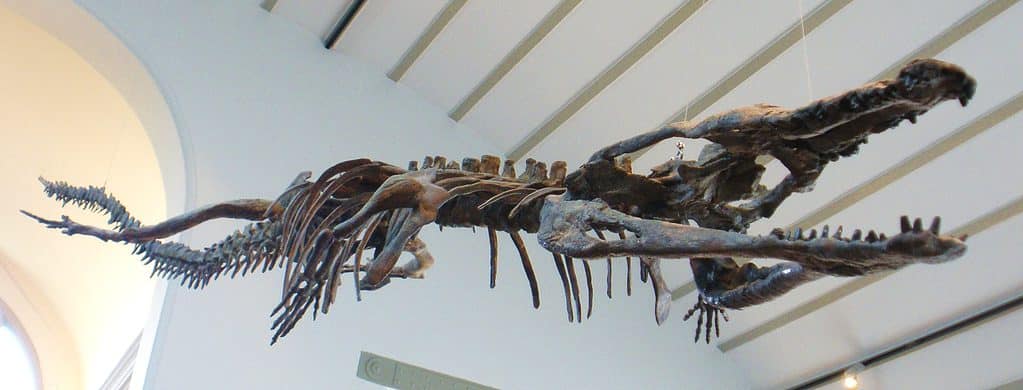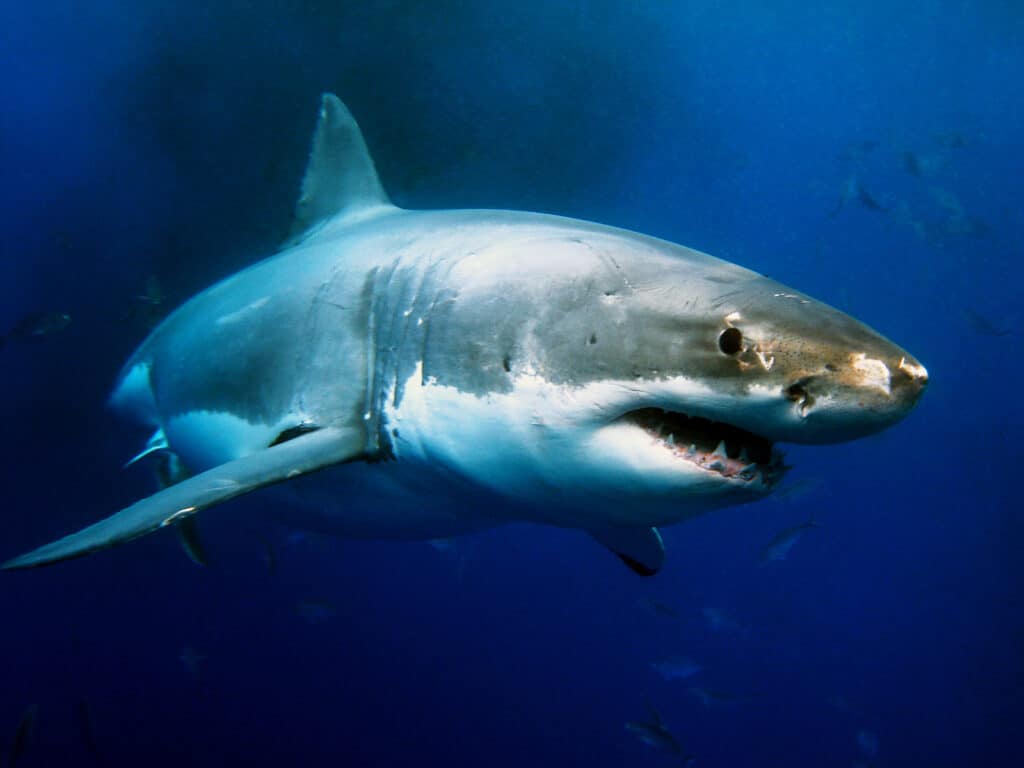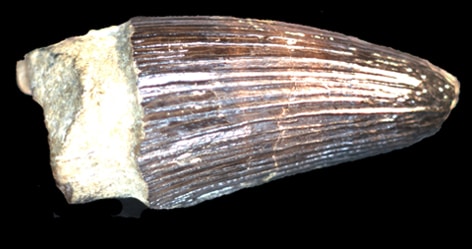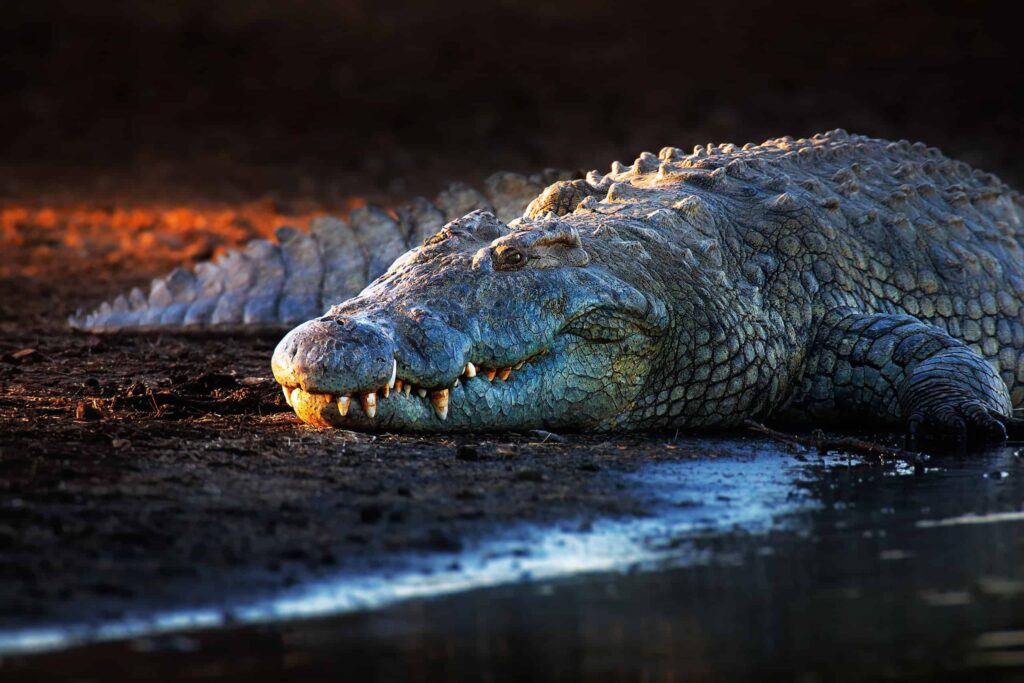Humans fear great white sharks more than many other creatures that dwell in the ocean. While they’re certainly dangerous, they’re not the worst thing in the waters these days. Also, they pale in comparison to the horrors that once waited in the deep. To illustrate that point, we’re going to have a hypothetical battle between the largest sea-dwelling crocodile vs. a great white shark.
You’ll see how easy it is for Machimosaurus rex, the largest sea-dwelling crocodile, to match with the great white shark. We’ll take some time to show you how the two animals are alike and different, and then we’ll tell you which one is most likely to win the battle.
Comparing the Largest Sea-Dwelling Crocodile and a Great White Shark
| Largest Sea-Dwelling Crocodile | Great White Shark | |
|---|---|---|
| Size | Weight: from 5,000 pounds up to 6,600 pounds Length: from 20 to 23, possibly up to 35 feet | Weight: 1,500 to 2,400 pounds on average, up to 5,000 pounds Length: between 11 and 16 feet on average, up to 21 feet or more |
| Speed | – Unknown swim speed – The largest modern crocodiles, saltwater crocodiles, swim up to 18 mph – Probably could not match the great white due to its size | – 20 to 35 mph at top speed |
| Defenses | – Immense size would scare off most lone challengers – If it had a body like modern crocodiles, its flesh would be reinforced with osteoderms | – Their coloration makes the shark difficult to see from above and below – Has amazing hunting senses to find nearby danger – Large body makes it difficult to land a fatal blow without a dangerous counterattack – Can simply outpace most creatures while swimming |
| Offensive Capabilities | – Bullet-shaped teeth designed to hold and break bones – Teeth only measured about 1.5 inches long – Immense bite force that almost certainly exceeded a great white shark based on its size | – Powerful bite force of 4,000 PSI – Has rows of serrated teeth with 50 teeth free to bite at any time – Teeth measure up to 3 inches, so the creature can remove a lot of flesh with a single bite |
| Predatory Behavior | – Most likely ambushed turtles and other creatures in shallow water | – Uses its senses to find and position itself below and behind prey before ambushing them |
What 3 Are Key Differences Between the Largest Sea-Dwelling Crocodile and a Great White Shark?
The biggest differences between the largest sea-dwelling crocodile and a great white shark are their size, speed, and the shape of their teeth. The sea-dwelling crocodile was much larger than the average great white shark, weighing between 5,000 and 6,600 pounds and growing possibly up to 35 feet long while the great white weighs between 1,500 and 2,400 pounds on average and grows between 11 and 16 feet on average.
Machimosaurus rex may have had a swim speed that was near or less than 20 mph based on saltwater crocodiles that exist today, but we don’t know for certain. Meanwhile, a great white shark can swim at speeds of 20 to 35 mph at its top speed.
Lastly, the teeth of a great white shark are sharp and serrated, designed to tear flesh, but the largest sea-dwelling crocodile had blunt-tipped, bullet-shaped teeth that were made to hold prey and crush bones.
These key differences will play a major role in determining which of these animals would win the fight, but we need more data and context to decide the winner.
What Are the Key Factors in a Fight Between the Largest Sea-Dwelling Crocodile and a Great White Shark?
Most fights in the animal kingdom can be broken down according to five factors. They include predation methods, offensive powers, defenses, speed, and size. By exploring each of these elements for both creatures and comparing them, we can find out which animal has certain advantages in this fight. Let’s begin breaking down these factors.
Largest Sea-Dwelling Crocodile vs. Great White Shark: Size
The largest sea-dwelling crocodile is bigger than a great white shark. The Machimosaurus rex weighed between 5,000 and 6,600 pounds and grew from 20 to 23 feet long, possibly up to 35 feet. The average great white shark weighs 1,500 pounds to 2,400 pounds, but it can reach 5,000 pounds in total weight. They grow about 11 to 16 feet on average, but they can get as long as 21 feet long.
The largest sea-dwelling crocodile has the size advantage.

The largest sea-dwelling crocodile
Machimosaurus rexhas a size advantage over the great white shark weighing up to 6,600 pounds.
©Ghedoghedo, CC BY-SA 3.0 <https://creativecommons.org/licenses/by-sa/3.0>, via Wikimedia Commons – License
Largest Sea-Dwelling Crocodile vs. Great White Shark: Speed
The great white shark is probably faster than the crocodile. Humans know that great white sharks can use a burst of speed to reach about 35 mph while hunting. The largest sea-dwelling crocodile probably could only muster about 20 mph based on the speed achieved by modern saltwater crocodiles. At any rate, it doesn’t seem likely that they could swim as fast as a great white.
The great white shark has a speed advantage in this fight.

The great white shark has a speed advantage in this fight with a burst of speed that can reach about 35 mph while hunting.
©Alexius Sutandio/Shutterstock.com
Largest Sea-Dwelling Crocodile vs. Great White Shark: Defenses
The great white shark has a large, cartilaginous body that would be hard for most sea creatures to successfully attack due to size alone. Moreover, the shark’s hunting senses would probably make it hard to ambush the shark. Failing that, great white sharks have a coloration that makes them hard to spot, and they can simply swim away from all but the fastest sea creatures.
Meanwhile, the sea-dwelling crocodile would rely on its size to ward off most challengers. Even so, the crocodile probably had a thickly built body with tough skin that was reinforced in osteoderms. Biting into this creature would be very difficult.
The great white shark has more defenses, but the sea-dwelling crocodile has more powerful physical defenses, so this is a tie.
Largest Sea-Dwelling Crocodile vs. Great White Shark: Offensive Capabilities
One of the many reasons that people fear the great white shark is its bite force. This creature can exert 4,000 PSI, driving 3-inch serrated teeth into its prey and tearing away huge amounts of flesh in a single bite. Combined with the shark’s speed, stealth, and hunting habits, great white sharks are a biological powerhouse.
Yet, the largest sea-dwelling crocodile was no less dangerous. Based on its size and jaw structure, it’s very likely that this crocodile had a greater bite force than a great white shark. However, its teeth were bullet-shaped, blunt-tipped, and only measured about 1 to 2 inches. They were designed to grab, hold, and crush prey.
The largest sea-dwelling crocodile has an offensive advantage based on greater bite force.

The largest sea-dwelling crocodile had bullet-shaped teeth and greater bite force.
©Niko Hoffmann, CC BY-SA 3.0 <http://creativecommons.org/licenses/by-sa/3.0/>, via Wikimedia Commons – License
Largest Sea-Dwelling Crocodile vs. Great White Shark: Predatory Behavior
The great white shark is an ambush predator that can use its amazing array of senses to find and kill its prey. They ambush with speed and silence, attacking from where their prey can’t see them.
Meanwhile, the crocodile probably attacked creatures in shallow water, possibly killing turtles and fish. However, they could have also grabbed land animals that went into the water for any reason.
The great white shark has the advantage in predatory behavior.

The great white shark has the advantage in predatory behavior, ambushing prey with speed and silence.
©Vincent Legrand/Shutterstock.com
Who Would Win in a Fight Between the Largest Sea-Dwelling Crocodile and a Great White Shark?
The largest sea-dwelling crocodile would win a fight against a great white shark. The great white shark would almost certainly land the first bite, but it would face a problem. The crocodile’s reinforced skin would diminish the power of the great white shark’s bites. Also, the crocodile’s size relative to the great white’s mouth could pose a problem with landing an effective bite. If the shark can’t bite the huge creature very well and rend a great deal of flesh at the start of the fight, the great white is going to face a serious challenge.
Injured, the largest sea-dwelling crocodile would counter, partially clamping down on the great white shark. The shark would wriggle free and keep trying to harass the crocodile’s hindquarters, receiving vicious tail smashes in return.
Having stunned the shark, the crocodile lands a huge bite with all of its force, clamping down on the great white shark and leaving it too injured to fight. Using its high bite force and teeth meant to bite, hold, and break bones, the crocodile breaks the shark’s cartilage-based spinal column.
While the crocodile probably couldn’t eat the massive shark, it would leave the shark too injured to fight back or ever hunt again.
If the largest great white fought against an average-sized crocodile, then the fight may end differently. Still, the great white would probably never hunt such a dangerous foe in the first place, and it would certainly face a significant risk by attacking such a large, vicious reptile.

The largest sea-dwelling crocodile, which was considerably larger than today’s crocodile, would win a fight against a great white shark.
©Johan Swanepoel/Shutterstock.com
Bonus: How Can You Tell an Alligator and a Crocodile Apart?

We’ve looked at some differences between the largest sea-dwelling crocodile ever vs the great white shark, and have seen that the crocodile would likely have come out the victor in a fight. Nowadays, crocodiles have a more modest size, and sometimes their habitats cross with those of the alligator. If you were in an area where alligators and crocodiles co-existed, would you be able to tell them apart?
In terms of physical characteristics, an alligator has a U-shaped snout, webbed feet, a wide upper jaw that hides the lower teeth and overlaps the lower jaw, and roughly 80 teeth. Its teeth measure from 1 inch for its smaller teeth to as much as 2 ½ inches for its largest. In color, alligators are dark gray or black with a cream underbelly.
Crocodiles, by comparison, have V-shaped snouts, feet that are not webbed but possess a jagged fringe, and upper and lower jaws that are roughly the same size, allowing the teeth to interdigitate. Crocodiles possess 60-70 teeth that are slightly curved and conical and protrude when their mouths are closed. Saltwater crocs have 66 teeth, some of which grow as long as 5 inches. Crocodiles’ teeth are not sharp, but are blunt, as they use them to hold prey tight rather than ripping them apart. Crocodiles are mostly olive green or light brown with a mottled pattern.
Alligators can be found in 2 locations–America (the American alligator) and China (the Chinese alligator). Crocodiles can be found in many more places worldwide: Egypt and 25 other countries in Africa (Nile crocodile), Asia, Oceania, South Florida, and South America (American crocodile). Regarding habitat, alligators prefer freshwater areas like swamps, rivers, lakes, ponds, and wetlands, while crocodiles are able to tolerate salt water, enabling them to inhabit lagoons and islands, as well as rivers, lakes, and mangrove swamps.
As far as prey goes, you’d likely observe either the alligator or crocodile eating the same animals: fish, birds, turtles, and various mammals. They are both apex predators that primarily consume other animals as their sole source of nutrition.
Finally, they differ in size. While alligators weigh from 400 lbs to 800 lbs and range in length from 8.2 feet to 11.2 feet, crocodiles are larger animals, measuring 10 feet to 20 feet long and weighing 300 lbs to 2,000 lbs. So if you are observing one of these reptiles in the wild, you’ll need to take into account its unique characteristics, its size, and the area you are observing it in to determine whether it’s an alligator or a crocodile.
The photo featured at the top of this post is ©
Sources
- Science, Available here: https://www.science.org/doi/abs/10.1126/science.181.4095.169
Thank you for reading! Have some feedback for us? Contact the AZ Animals editorial team.






